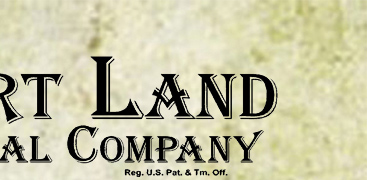610 and 630 Court Street Progress - 2016
December, 2016
Monthly Summary: At 630 Court Street preparations began for the installation of a steel moment frame along Main Street, while more steel columns were added along the Court Street façade. The building at 610 Court Street remained unchanged.
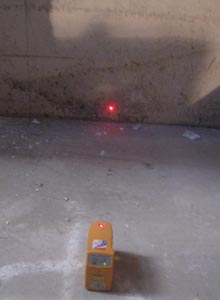
|
630 Court Street: A red dot on the top of a laser level projects a line from the basement floor, up three floors to the roof, in preparation for the installation of a steel moment frame on the interior side of the Main Street façade. This image shows the laser level on the basement floor, which is also projecting a line against the basement wall. |
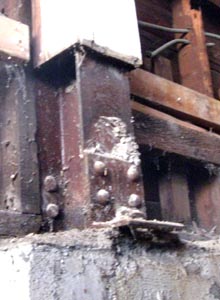
|
630 Court Street: An old riveted I-Beam column was exposed when removing a section of floor for the Main Street façade's moment frame. |
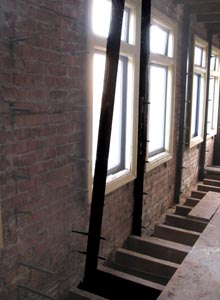
|
630 Court Street: A new steel column, ready for installation on the upstairs brick wall along Court Street, leans away from the wall. Other, already installed, steel columns are to the right. |
November, 2016
Monthly Summary: At 630 Court Street the installation of steel columns continued along the Court Street façade. The project on the lower story of 610 Court Street remained unchanged.
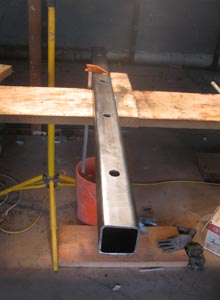 |
630 Court Street: A short steel column sits on a fabrication bench. This column is short because it will be placed in the limited space above an existing first story window. |
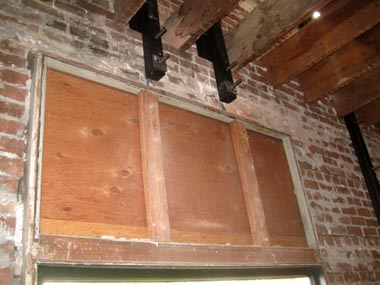 |
630 Court Street: This image shows two short steel columns installed above an existing first story window. Two columns, close together, had to be installed because the engineering plans do not allow the columns to be more than 60 inches apart, and there was just over 120 inches between the columns on both sides of the window. A full-length column is seen at the far right of the image. |
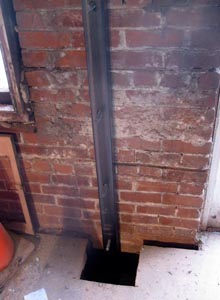 |
630 Court Street: Full length steel columns along the Court Street façade had to be installed through the floor, down to the concrete foundation. As of the end of November, 2016, the installation of columns is about 2/3rds complete along the Court Street façade. |
October, 2016
Monthly Summary: Hole drilling, the installation of steel, and interior demolition continued at 630 Court Street. The project on the lower story of 610 Court Street remained unchanged.
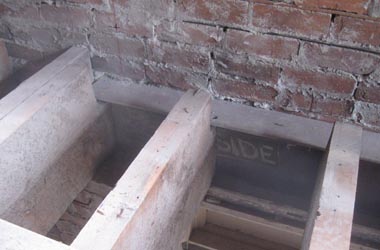 |
630 Court Street: Demolition revealed an original I-Beam in the Court Street wall. |
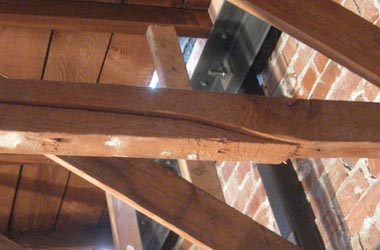 |
630 Court Street: A broken roof truss was discovered when part of the ceiling was removed. |
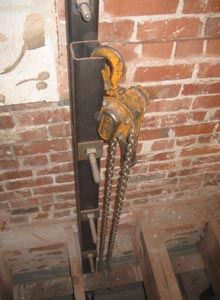 |
630 Court Street: A chain hoist is used upstairs to raise an angle iron into position at the bottom of the first floor ceiling joists. |
September, 2016
Monthly Summary: At 630 Court Street hole drilling and interior demolition along the Court Street wall continued. The project on the lower story of 610 Court Street remained unchanged.
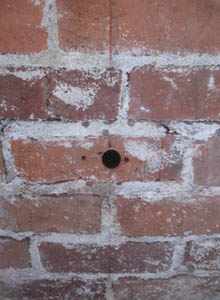 |
630 Court Street: The drilling of holes into the brick wall facing Court Street continued. After carefully measuring and marking each hole (see the red vertical line and black dots), each hole is drilled at a 22-1/2 degree angle on the interior side of the wall. Cleaning out the brick dust follows. A bent threaded rod will later be epoxied into the hole to hold a steel column tight against the bricks. |
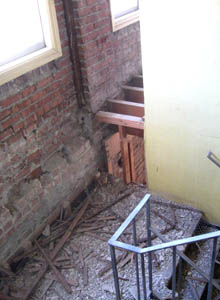 |
630 Court Street: Demolition continued along the Court Street wall. This image shows demolition in one of the stairwells. |
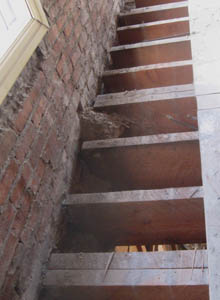 |
630 Court Street: This image shows a portion of the upstairs floor that was recently removed to allow the steel columns to be installed. |
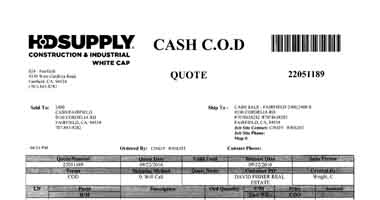 |
630 Court Street: An order for 280 bent threaded rods was submitted to our supplier. These rods will be needed for the Court Street wall. Four different lengths of rods were ordered, each to fit a particular thickness of wall or size of steel column. |
August, 2016
Monthly Summary: At 630 Court Street work was suspended for most of the month while plans for the reinforcement of the Court Street façade were revised and reviewed by the City. The status of 610 Court Street remained the same.
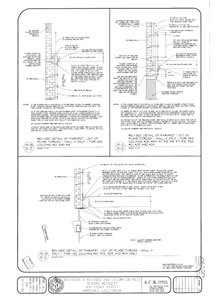 |
630 Court Street: Revised plans for reinforcement of the wall along Court Street were finalized and then submitted to the City for review. The City approved the revisions and work started on drilling holes on the inside of the Court Street façade. |
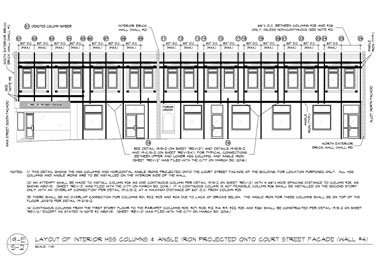 |
630 Court Street: The revised plans provide for the inside of the Court Street façade to be reinforced by a steel frame consisting of twenty-six steel columns tied together with three horizontal steel angle irons. This image depicts the steel frame projected onto the Court Street façade to show how the frame will avoid the windows and doors. |
July, 2016
Monthly Summary: At 610 Court Street work on removing “humps” in the floor of one downstairs suite was completed. At 630 Court Street, seismic retrofit work continued.
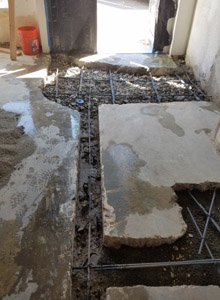 |
610 Court Street: Rebar is installed in the areas where the floor had to be removed due to “humps” that existed where walls had been removed during a prior remodel. |
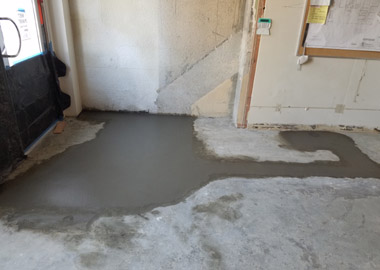 |
610 Court Street: Concrete was poured to finish the floor leveling process in a downstairs suite. |
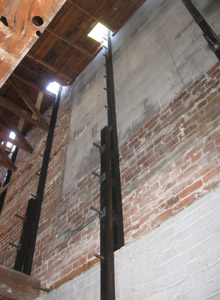 |
630 Court Street: Steel “strong backs” were placed over the bolts that had been epoxied into the wall in June. These steel columns go through holes cut in the roof so that the building’s parapet can also be reinforced without needing a separate reinforcing system. |
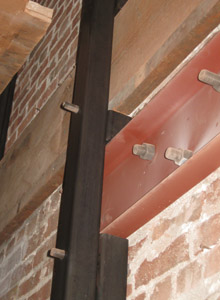 |
630 Court Street: New steel columns are installed using a special design that avoids having to remove reinforcing steel constructed during a previous remodel. In this photo, washers and nuts have not yet been put on the new bolts. |
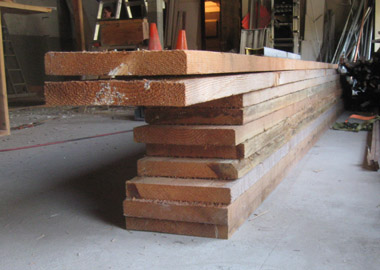 |
630 Court Street: Rough‑sawn Douglas Fir lumber sits in a stack after arriving from our supplier, Berry's Sawmill in Cazadero, California. Our retrofitting project encountered one area where the size of rough‑sawn lumber was required. Rough Douglas Fir lumber is no longer stocked on a regular basis in most lumberyards, so we get it directly from the mill ‑ ‑ they pull a few boards for us before they are sent through the planer. |
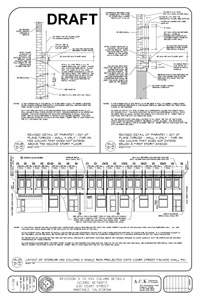 |
630 Court Street: Work could not commence on reinforcing the Court Street façade because conditions were encountered that were not anticipated when the retrofit plans were first drawn‑up. In late July, the engineer began work on a set of revisions to the plans. Once approved by the City, work can begin on the Court Street wall. |
June, 2016
Monthly Summary: At 610 Court Street work was commenced to level a concrete floor in one of the downstairs suites. At 630 Court Street, the project was delayed pending a special inspection by the engineer. Once the work passed that inspection, more rods were epoxied into the walls.
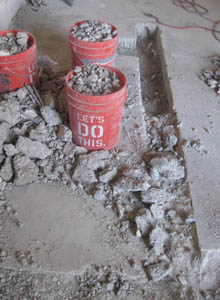 |
610 Court Street: A previous remodel had eliminated a concrete partition wall on the first story, however the wall was not fully removed, leaving a hump in the floor. Here, the old wall has been removed to a level below the top of the adjacent floor slab. Soon, it will be filled with rebar reinforced concrete to create a level floor surface. |
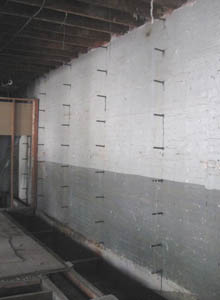 |
630 Court Street: The project was delayed for a couple of weeks because the engineer could not make it out for a field inspection. Work could not go forward until that inspection took place. Once the work passed the inspection, more bent rods were epoxied into the walls. |
May, 2016
Monthly Summary: At 630 Court Street the installation of steel reinforcement and the demolition of additional areas continued. The status of 610 Court Street remained the same.
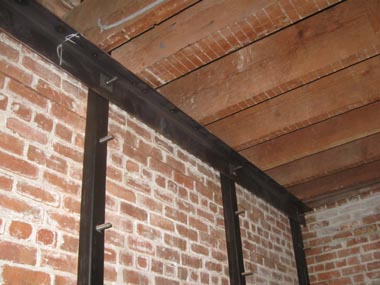 |
630 Court Street: A steel angle iron has been installed with one side flush against the steel columns along the wall and the other side flush against the bottoms of the second story floor joists. These angle irons will be installed in three separate locations, and act to tie the walls to the floors, ceilings and roof. |
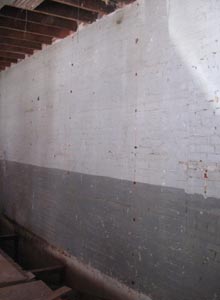 |
630 Court Street: Holes have been drilled in vertical groups in a brick wall, prior to the installation of epoxied rods. |
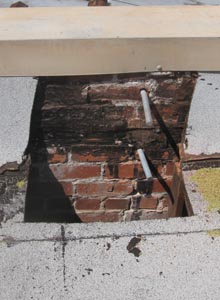 |
630 Court Street: Hot-dripped galvanized rods after being epoxied into the building's parapet. A steel reinforcing column will run through the rectangular hole cut in the roof to secure the parapet. |
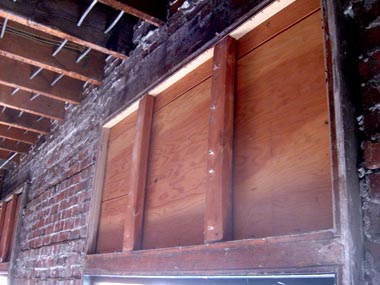 |
630 Court Street: Demolition revealed plywood where a transom window once was. A new transom window will have to be manufactured in order to properly restore the building to the way it looked when built in the 1920’s. |
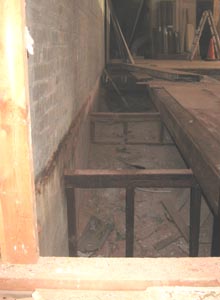 |
630 Court Street: Demolition also revealed a ramp that once led to the basement. |
April, 2016
Monthly Summary: At 610 Court Street the final stainless steel storefront was installed and the elevator car received some finishing touches. At 630 Court Street, the seismic reinforcement work continued.
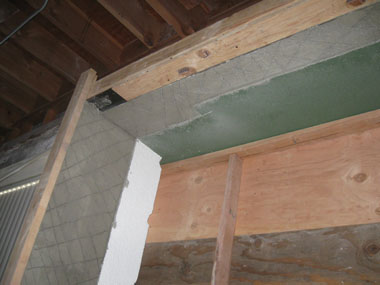 |
610 Court Street: A storefront alcove has been expanded inward to provide more room for the swing of the new door. The gray-colored stucco “scratch coat” in this image shows the extent of the expansion; the plywood temporarily blocks-off the alcove at the property line (the back of the sidewalk). After the stucco “top coat” is added, the storefront will be installed. |
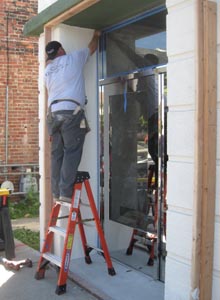 |
610 Court Street: The fourth and final mirror finish stainless steel storefront being installed in one of the building's alcoves. |
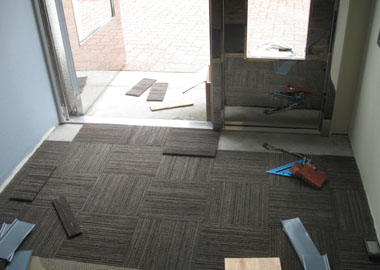 |
610 Court Street: After the installation of the new storefront leading to the elevator lobby, the last row of carpet squares were installed. |
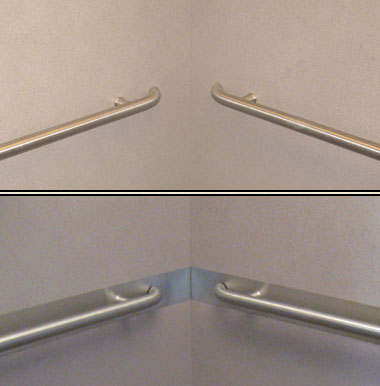 |
610 Court Street: The final stainless steel trim pieces were installed in the elevator car (see lower image.) Special stainless steel hand rails had been previously added in order to comply with the American's with Disabilities Act (upper image), however the rails did not have the same hole pattern as the prior ones. The trim pieces were added to hide the old holes and to further enhance the stainless steel theme of the building. |
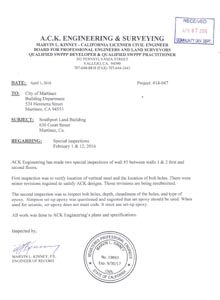 |
630 Court Street: A letter from the engineer who is supervising the seismic reinforcement work was filed with the City certifying that certain parts of the project have undergone special inspections. These letters have to be periodically filed to show the City that the work is being performed properly. |
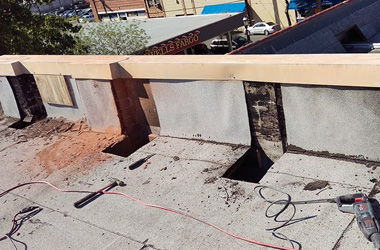 |
630 Court Street: As a part of the seismic retrofit work, steel columns have to be installed vertically on the brick walls. In order to strongly secure the building's parapet above the roof, the columns are to be run continuously from the floor of the second story upward. In this image, holes have been cut in the roof to allow installation of the steel columns from below. |
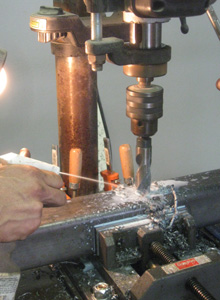 |
630 Court Street: A water-based coolant is sprayed on the bit while a hole in one of the steel columns is drilled. |
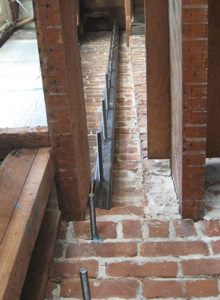 |
630 Court Street: After holes are drilled in the steel columns, they are installed against the bricks using all-thread rods that were previously epoxied into the bricks. This image is looking up from the first story, through the second story's floor joists, at a steel column that has just been added to secure a second story wall and the parapet. |
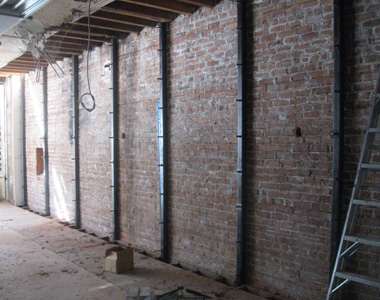 |
630 Court Street: A group of steel columns installed along a brick wall. |
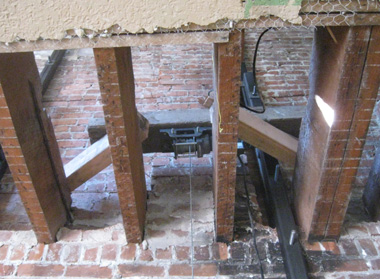 |
630 Court Street: An electric winch is placed above the second story floor joists so that pieces of steel angle iron can be raised into a horizontal position. |
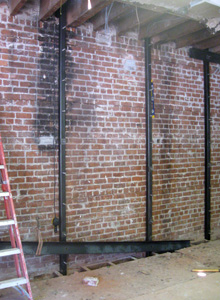 |
610 Court Street: The winch begins to raise a 20-foot long piece of steel angle iron. One side of the angle iron will be installed flush against the steel columns along the wall. The other side will be installed flush against the bottoms of the second story floor joists. The angle irons will serve to tie the walls to the floors, ceilings and roof. |
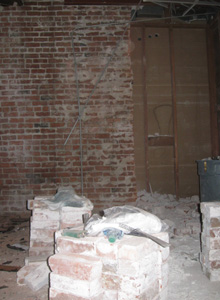 |
630 Court Street: Demolition revealed that a few feet of an interior brick wall had a thickness of only one brick, making that part of the wall unsafe and very difficult to reinforce. Since it was an interior wall, the engineer decided to remove the portion that was one-brick thick. In this image, the thin section of wall has been removed and the bricks piled in the foreground. |
March, 2016
Monthly Summary: At 610 Court Street preparations were made to instal new doors and sidelights, and three of the four new doors were actually installed. Interior demolition work continued at 630 Court Street, and a steel channel was discovered from a prior retrofit which required a re-design of the current plans for that one wall.
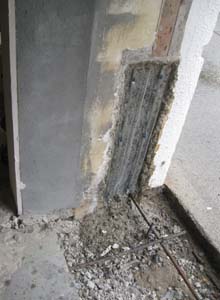 |
610 Court Street: Where doors are to be installed in the former window wells along Court Street, concrete had to be poured as a pedestrian entrance and stucco added to the side walls to match the existing. This image shows rebar at the concrete entrance and steel lath which will hold the stucco. |
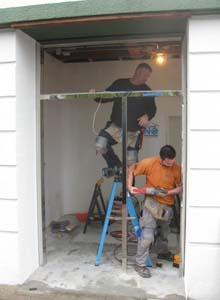 |
610 Court Street: Workers instal the frame for a new door and sidelight where a window once existed. |
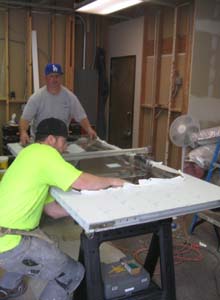 |
610 Court Street: Workers remove the protective plastic coating from a mirror finish stainless steel door which will be installed along Court Street. When complete, there will be four new entrances along Court Street, one for the upstairs elevator lobby and one each for three downstairs suites. |
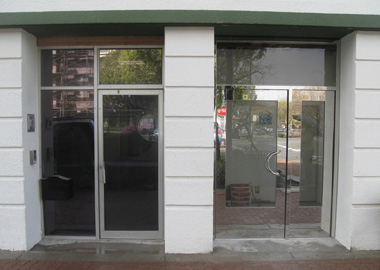 |
610 Court Street: This is a “before” and “after” image of the doors. On the right is a new door and sidelight installed where a window once was. On the left is one of the old entry doors and sidelights which will be replaced. By the end of March, three of the four new doors and sidelights had been installed. |
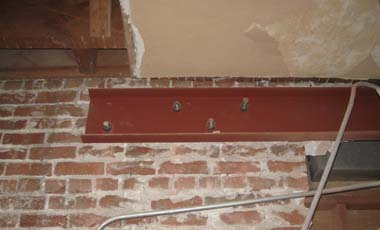 |
630 Court Street: A steel channel from a prior seismic retrofit was uncovered during demolition for the current seismic work. Under the approved plans, a vertical steel column was to be placed against the bricks in this location. This discovery required that the reinforcement for that wall be redesigned, causing a delay. |
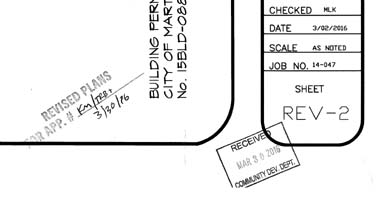 |
630 Court Street: On March 30, 2016, revised plans to address the newly discovered steel channel were approved by the City. |
February, 2016
Monthly Summary: Most of the pieces for the storefronts at 610 Court Street were delivered, the painting on Escobar Street was nearly completed, and the official elevator permit arrived. Engineering inspections took place at 630 Court Street as a part of the on-going seismic reinforcement work.
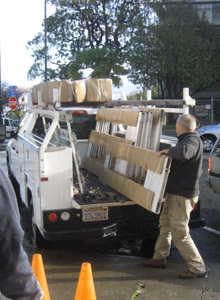 |
610 Court Street: Most of the pieces for the storefronts arrived from the contractor's warehouse. Two critical pieces were found to be manufactured incorrectly, so it will be March before the first storefront can be installed. |
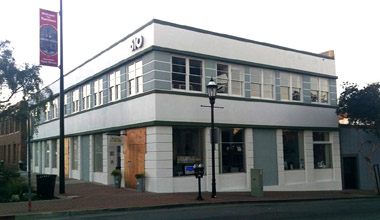 |
610 Court Street: The painting of the Escobar Street façade was substantially completed. Only a small part in the upper corner remains to be done. |
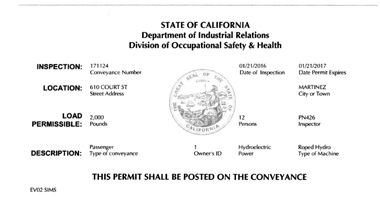 |
610 Court Street: The official permit to operate the elevator arrived from the Department of Industrial Relations. |
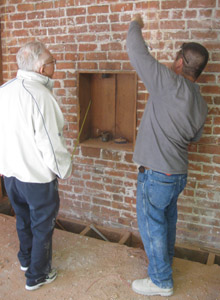 |
630 Court Street: Engineer Marvin Kinney inspects a hole drilled in a brick wall. The holes must be inspected before bent rods can be epoxied into them. The engineer also had to be present to observe the epoxying process to ensure it was being done properly. |
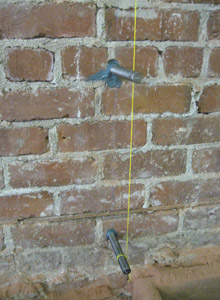 |
630 Court Street: The first few epoxied rods. The string line keeps the rods in line for the steel columns that will eventually be held against the bricks by the rods. The blue-green colored substance around the rods is the epoxy. |
January, 2016
Monthly Summary: At 610 Court Street the elevator was certified and granted its operating permit, the upstairs received finishing touches, painting was begun in the downstairs common area (inside) and along the Escobar Street façade (outside). At 630 Court Street, as a part of the seismic reinforcing work, preparations were made for drilling the steel columns, and bent rods arrived at the job site.
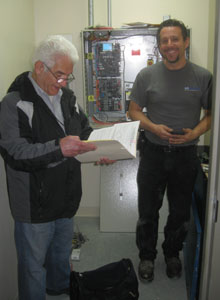 |
610 Court Street: Joe Speel of Pac West Elevator (right) smiles after the State Elevator Inspector (left) certified the elevator for passenger use. |
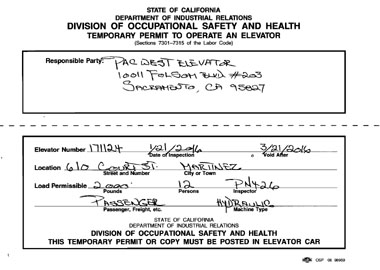 |
610 Court Street: The temporary permit to operate the elevator. |
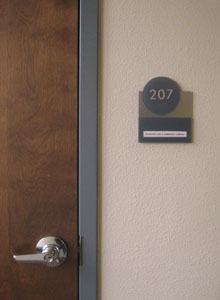 |
610 Court Street: Signs were added throughout the second floor. This sign is at the door to Suite 207. |
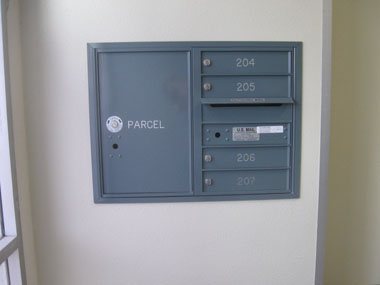 |
610 Court Street: A mailbox unit for the upstairs suites was added in the downstairs lobby. |
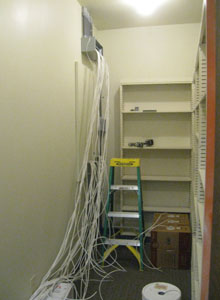 |
610 Court Street: Communication cables were added in previously installed conduit inside a closet of one of the upstairs suites. |
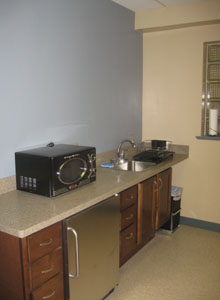 |
610 Court Street: Appliances and other furnishings finish the break room in the upstairs common area. |
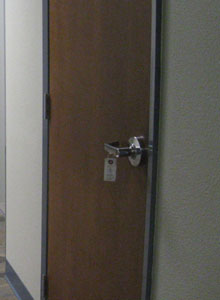 |
610 Court Street: All upstairs door keys were tagged for a future tenant. |
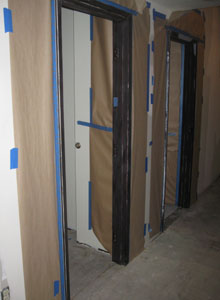 |
610 Court Street: Masking for painting door frames in the downstairs common area. |
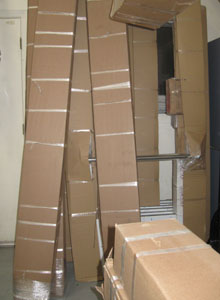 |
610 Court Street: Boxes containing the new storefront doors arrived at the contractor’s warehouse. These pieces were trucked all around California, from the manufacturer to the cladding sub-contractor near Los Angeles, then back to the manufacturer in Hayward to add hardware, then to the storefront contractor's warehouse in Pittsburg. |
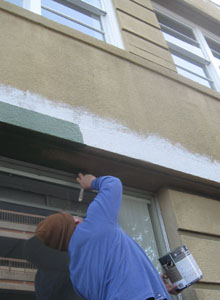 |
610 Court Street: Painting of the façade along Escobar Street was begun. |
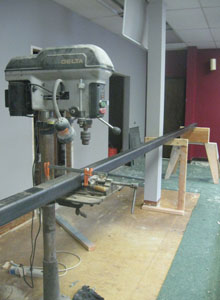 |
630 Court Street: In order to drill holes for bolting steel columns to the brick walls, a drill press with nearby supports for the columns was set-up. These columns will become vertical “strong-backs” to reinforce the brick walls. |
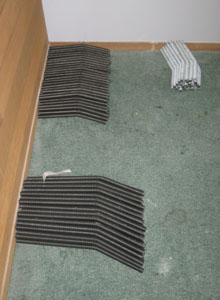 |
630 Court Street: All-thread rods, bent at a 22-1/2 degree angle, arrived from the manufacturer. Holes will be drilled in the brick walls at an angle, so that the rods, after being epoxied into the wall, will stick-out horizontally. Steel columns will then be bolted to the rods. |
|
| |
|
| |

